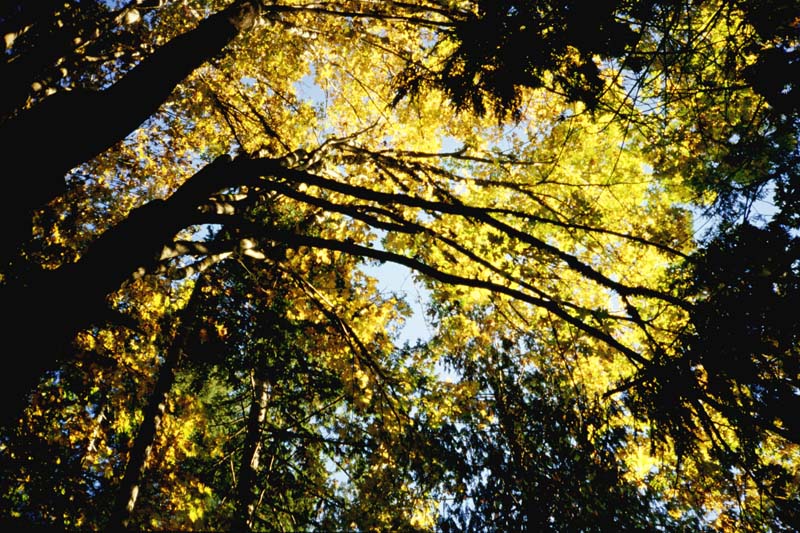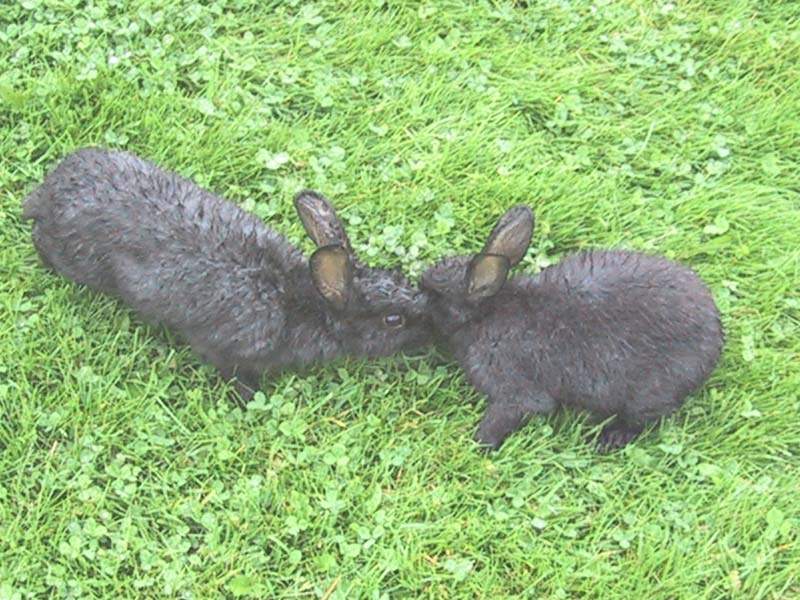lothlorien

maples, Cortes Island, B.C.
Autumn has settled onto this mossy island and the massive maples have taken on the golden hue of the mythical Mallorn-trees of Tolkein’s Lothlorein. But as in Middle Earth, the calm of the forest in which I find myself has an unsettled, internecine quality, as the distant thrumming of the massing, apocalyptic armies becomes ever more palpable. Activists, astrologers, political pundits, climatologists and zoologists all seem to agree that we are at some sort of historical cusp, with the bifurcation point being the upcoming American election.
Of course, like everyone else, I have been engrossed in the minutiae of “the debates” and wondering whether Bush has finally been completely transformed into one of the supermarionetic Thunderbirds I so loved watching as a child. The theories around Bush’s “wire” have been all over the net lately, but for me the penny dropped when he appeared halfway through his first campaign with a large Band-Aid on his cheek and suddenly started speaking more coherently, albeit with an unsettling kind of parsed pacing, as if he had to wait for a download between phrases. Some sort of audio transducer implanted into his maxillary bone seems to make the most sense to me. Since then, my question has always been: “Why *wouldn’t* Bush be wired?” I mean, could the plutocrats at the helm of the world’s only superpower actually leave the operation of Bush’s mouth to chance? Not likely. In fact, Bush is the perfect subject for this kind of augmentation; his naturally dazed and hypnotic expression and apparent absence of intellectual capacity would make his brain/mouth connection a pretty easy hack.
I’ve been outside a lot lately, since returning from New York, stratifying the seeds of the exquisite Davidia involucrata or Dove Tree and the Caucasian Wingnut, which I collected at the Brooklyn Botanical Gardens. Far overhead, across the great blue vault of oceanic sky, skeins of wild geese stream southward just beneath the endlessly forming and disintegrating grid of contrails left by the trans-Pacific jetliners, ferrying their cargos of bleary-eyed passengers back and forth across the date line. An idyllic autumnal image to be sure, but NASA has reported that contrails contribute noticeably to global warming, by increasing the amount of cirrus clouds in the upper atmosphere. Even the beloved croaking of tree frogs that (for now) still echoes through these damp woods is no longer to be taken for granted. Global amphibian populations are in free fall and nobody seems to have a clue as to why. There are the usual perplexed mutterings about “the canaries in the coal mine” but frogs are going extinct, even in protected areas, which have up till now been thought to be relatively pristine. Maybe frogs can look into the future and are burrowing towards the centre of the earth because they see what’s coming. They can, after all, predict the weather. . . Scientists are similarly bewildered by what the Guardian calls an “unexplained and unprecedented rise in carbon dioxide in the atmosphere two years running”, which may mean that instead of having decades to bring global warming under control, we have only a few more years. The nightmare scenario is that this is the first sign of the breakdown in the Earth’s natural systems for absorbing CO2, leading to the dreaded “runaway greenhouse effect” and total climate meltdown.
Creatures everywhere seem to be scurrying for cover, even ones that haven’t been discovered yet. There has recently been a spate of reporting on sightings of new humanoids, which although long existing in the realms of myth and crypto-zoology, are now proving to be scientifically plausible. The BBC reports on a new species of two-metre tall great ape sighted in the north of the Democratic Republic of Congo, which according to local villagers is “ferocious, and even capable of killing lions.” It clearly doesn’t want to be found. In Sumatra, there is fresh evidence supporting claims of the existence of the orang pendek, another as yet undiscovered species of hominid ape (or person?), said by the islanders to “walk like a man.” Whether or not these mysterious apes, yetis and sasquatches ever are proven to be walking this earth in our time, there is something sad about the fact that under the present onslaught of massive deforestation and climate change, the habitat that it would take to support them, will soon no longer exist. Much of the magic in these creatures lies in the fact that they haven’t been found by us and, real or imagined, the fact that they might exist, implies that somewhere there is still a nature big enough for them to hide in.
Perhaps these fleeting glimpses of hairy bipeds are really manifestations of our own deep longing for an ecological innocence that we have long ago lost, -a kinder, simpler more feral version of ourselves, reminiscent of the mysterious, mediaeval, heraldic figure of the “green man”, still living invisibly somewhere in the wildernesses of our own minds, gazing incredulously out at the carnage wrought by his future self.
Yet within this maelstrom of ecological destruction there are signs of hope. In Australia, hundreds of people are queuing up to view the putrid flower of the suggestively named Amorphophallus titanum, or titan arum, which at full bloom is said to smell like a large rotting corpse. Hooray! Anomophilia is alive and well, at least in the Antipodes. The Guardian is reporting that Chernobyl’s now flourishing ecosystems have prompted the UN to suggest that the area be developed as a nature reserve and ecotourism destination -albeit one with an unpredictable future, as experiments using fruit flies exposed to the blast have shown the problems of genetic mutation don’t emerge until the 26th generation. Maybe one day tourists to the site will thrill to the sight Cerberus-like wolves howling at a sallow Ukranian moon with multiple heads, or perhaps bio-luminescent wild boars rooting through the verdant new Elysian fields blanketing the ruins of Chernobyl’s now picturesque sarcophagus. Down in Mexico, the olive ridley is bucking the trend of world-wide sea turtle extinction, thanks to the armed guards now stationed on its nesting beaches -no doubt delighting the rich white tourists who flock there to commune with ‘authentic’ nature.
As an escape from the psychogeography of despair, and to address an overwhelming urge I’ve always had to fix stuff, I have, over the past decades, engaged in what could arguably be called a kind of ecological Situationism. The folks over at Flickr have made it possible for me to start putting the documentation of some of these ‘botanical interventions’ on-line, in a simple accessible format. So far, I’ve uploaded slide shows of my “Healing the Cut – Bridging the Gap” land art project as well as a history of Cottonwood Gardens, of which I was a founder and designer. Documentation of my recent “Means of Production” project can still be found here, on my plone site, but I will set up a Flickr slide show of this shortly.
Oh, and I am *so* pleased to see Laura Trippi as well as William Gibson blogging again, both after a long hiatus. Says Gibson, quoting the Spanish philosopher Miguel de Unamuno
— “At times, to be silent is to lie.”

bunnies, Victoria B.C.

dam(n), near Castlegar, B.C.



